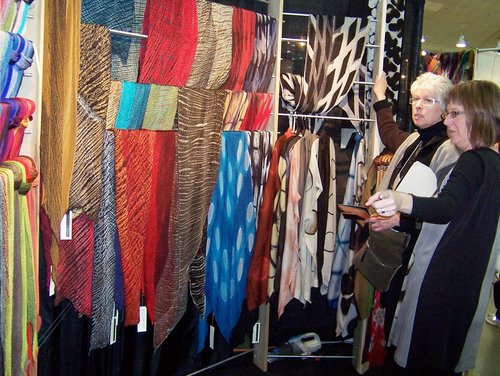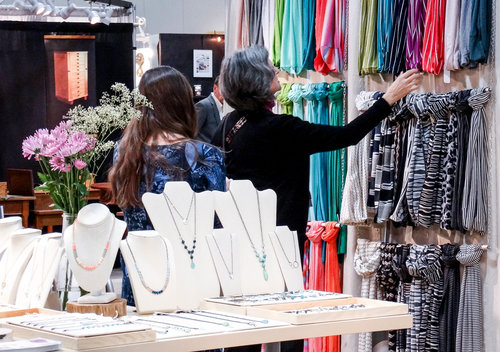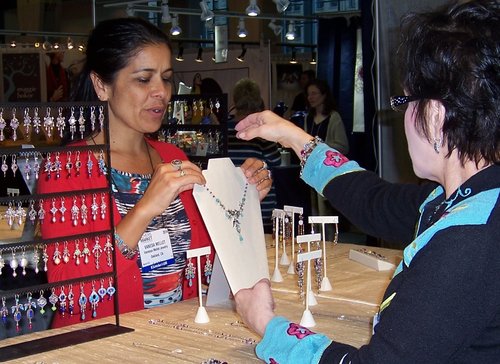by Carolyn Edlund
Appeal to shoppers with a display of your art or handmade work that presents beautifully and invites sensory engagement.

Merchandise displayed on an aisle engages customers immediately.
A veteran shopper was recently asked whether she purchases gifts online, and declared, “Never. I want to see and feel the merchandise before I buy it.” Despite the surge in online shopping, this attitude isn’t unusual. There is great value in exhibiting your art or handmade items in person to enable potential customers to view and handle products before making a decision.
Art fairs and festivals, pop-up galleries, open studio events and alternative spaces all give you this opportunity. Meeting customers and sharing your story is the beginning of building relationships with them as fans and collectors. But first, your presentation must draw attention and pull them in. Appealing to the senses is a very powerful way to encourage shoppers to engage.

The touch factor is a powerful tool in closing the sale.
Plan a welcoming display
Whether your booth is indoors or outside, you can set the tone with an inviting display.
Think of the entranceway to your booth as an invisible boundary line. Some shoppers hesitate to cross it, feeling that they might be cornered by a salesperson. Overcome that problem by bringing merchandise right to the aisle. A display that invites touching or provides other sensory delight engages people where they are rather than asking them to commit to stepping in. Meanwhile, make sure the booth entrance is wide open and easy to enter, encouraging further shopping.
Design your booth like a gallery. Use plenty of lighting and provide breathing room for each piece on display. This conveys a sense of higher value for your art or handmade work, whereas darker booths and cluttered merchandising tend to make the work look like commodity items.
Top of counter
Making your work “touchable” means making it accessible. Granted, high-end items, precious metals and gemstones must be protected from theft. But consider how you can securely display some of your merchandise on the top of the counter to begin the sensory “conversation” with shoppers. Then, bring out more expensive pieces individually from the case as needed.

Top of counter displays encourage customer interaction.
Place items in the customer’s hand
Merely handling a piece of your work gives shoppers important sensory information. They can feel the texture and thickness of a particular textile, or the weight of a handmade pen. The powerful sense of touch increases their confidence in the quality of the item itself. The simple act of placing merchandise in the shopper’s hand conveys a sense of ownership to them. And, it demonstrably increases not only sales, but the willingness to pay more for that item. It’s been said that when a customer picks up an item “it is three-quarters sold.”
Engage all the senses
Sensory experiences matter, and savvy sellers take advantage of this. Food vendors know the value of handing out free samples, and the sales that result. Vendors who sell lotions, soaps, scents or herbal products can capitalize on the fragrance of their wares by setting up a display that smells delightful, with product that can be tested.
Any type of art or handmade work that entices the senses should be displayed to encourage interaction. Kaleidoscopes can be irresistible to pick up. Trying on jewelry and handmade wearables are logical steps in making a purchase. Your role as the artist is to understand how your customers best experience your work, and to make that a natural part of the sales process.


Speak Your Mind